Takoyaki literally translated means octopus fried, but they aren’t just fried octopus – they’re tiny, piping hot balls of batter filled with green onions, ginger, crispy tempura bits and octopus. It’s crisp, it’s gooey, it’s delicious.
The best Japanese street food
Takoyaki is one of Osaka’s quintessential street foods. Thankfully, you don’t have to travel to Osaka to try them – they’re basically found everywhere in Japan and are quite popular in North America too. If you ever come across a takoyaki stand, stay awhile and check out the takoyaki makers. They’re mesmerizing.
Professional takoyaki chefs have rows and rows of cast iron pans with half spherical molds. A dashi flavoured batter is poured into the molds and then each ball gets a piece of octopus, some ginger, and green onions. When the bottom of the balls are cooked, they’re flipped with skewers so that the inside batter flows out to create the other side of the ball. It’s amazing to watch a real pro. They’re fast, furious and churn out the little balls like there’s no tomorrow.
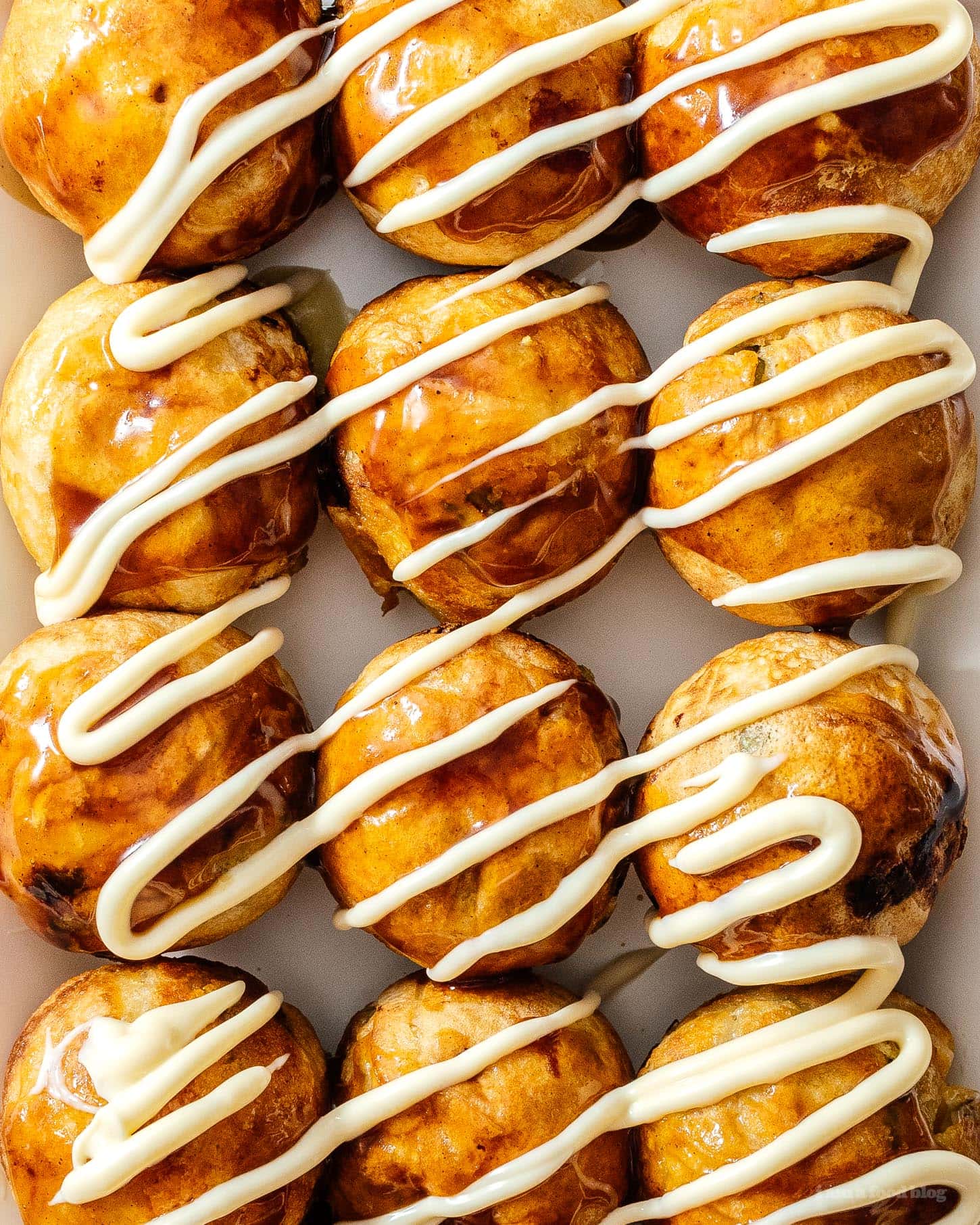

Why you should make takoyaki at home
Takoyaki need quite a few ingredients and a specialized pan, but I think it’s worth it. You can find a takoyaki pan on amazon.com or you can use an ebelskiver (Danish pancake) pan. As for the insides, octopus is classic, but feel free to put in shrimp, chicken, or whatever savoury filling you like. I like to do a combo of octopus, squid and shrimp. I also throw in some mozzarella cheese to get an crispy toasted cheese outside with an extra gooey cheesy inside. If you’ve never seen takoyaki being made, do a youtube search, it’ll give a good starting point for how to flip the little balls around.
What is takoyaki?
Takoyaki are a Japanese street snack that originated in the city of Osaka. They are little round balls of batter that are slightly crispy on the outside and a bit soft and gooey on the inside, stuffed with a little nugget of octopus, tempura bits, and green onions. Typically they serve them up in little wooden boats, brushed with takoyaki sauce, drizzled with Japanese kewpie mayo, and topped with bonito flakes and seaweed. They come with skewers or chopsticks to pick them up. They’re super popular and probably one of the most well known Japanese foods out there. Charmingly, you can almost always see people standing around the stands fanning their mouths because the takoyaki is too hot. Takoyaki is pure comfort food.
What does takoyaki taste like?
Takoyaki are delicious! They’re super savory and full of umami. They’re piping hot when they are served, so be careful when you eat them. The outsides are just a touch crispy and the inside batter is seasoned, soft, and kind of gooey that melts in your mouth. The little nugget of octopus inside is supposed to contrast with the softness of batter. Green onions add a bit of freshness, beni shoga (pickled ginger) adds a hint of sweet and sour, and crispy tempura bits add even more richness. The sauce and mayo on top adds another layer of flavor. Takoyaki are so incredibly full of umami. The perfect bite!
On mushiness: sometimes people are surprised by the texture of takoyaki. Is takoyaki supposed to be mushy? The answer is, yes, it’s supposed to be a little runny and gooey inside. It’s not exactly mushy, it’s more gooey like melty cheese. The gooey-ness is what most vendors aim for because the contrast is what makes takoyaki special. But, if you’re not a fan of gooey, you can be cook them all the way through. It just means that your balls will be a tiny bit more firm and structured than the ones you’ll find in Japan.
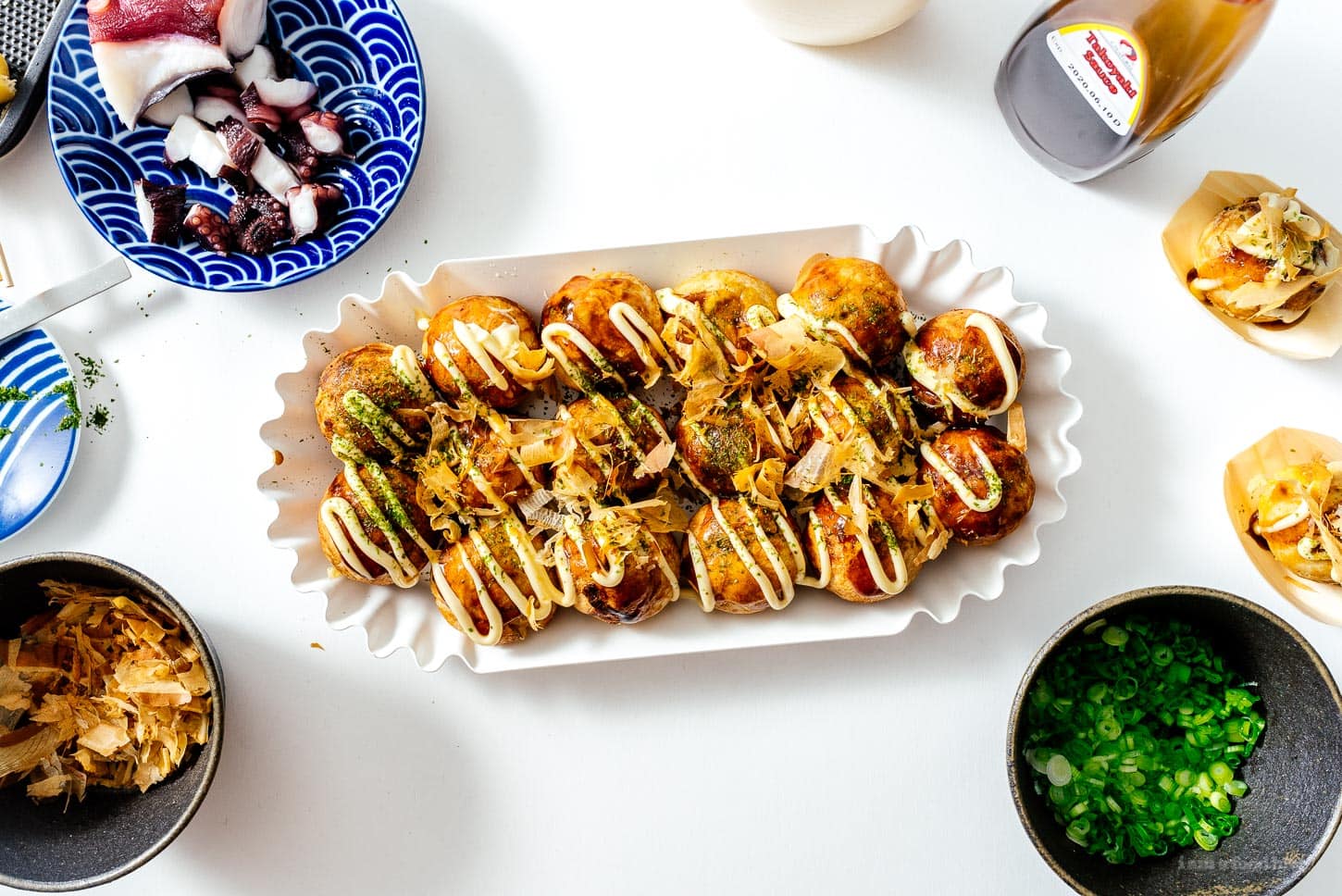

What is takoyaki made of?
There are a lot of ingredients needed for takoyaki, but don’t let that stop you – it’s absolutely worth it. In fact, one of my all time favorite activities is making takoyaki at the table. I have so many fond memories of Mike and I making takoyaki and chatting the night away.
Here’s what you need:
- Eggs. Eggs make up the majority of the batter and help it get crisp.
- Flour. Flour binds everything together into a very loose batter.
- Dashi powder. Dashi powder is what gives the batter it’s flavor – it’s a simple shortcut way of incorporating dashi (Japanese soup stock) into the base. You can buy dashi powder in the Asian grocery store or online. It adds a bunch of flavor and umami.
- Soy sauce. This is just to add some extra flavor.
- Octopus/tako. The reason why we’re here! You can buy already cooked tako at the Asian grocery store in the seafood section. Cut the tako up into cubes.
- Green onions. These add a bit of freshness to the takoyaki.
- Tenkasu. Tenkasu is tempura bits! They add texture and aroma. If you don’t have any (they sell them in bags at the Asian grocery store) then you can sub in rice krispies.
- Takoyaki sauce. A thick brown sweet and savory sauce.
- Kewpie mayo. This is essential and gives your octopus balls that iconic look.
- Bonito flakes. These flakes are what make your takoyaki look like it’s dancing! They are delicate, paper thin shaved dried fish that wave around from the hot steam. They are super savory.
- Seaweed. A little green sprinkle of powdered seaweed.
- A takoyaki pan. You can buy them for not too much money online, or if you have a Danish-style ebelskiver pan, that’ll work great too.
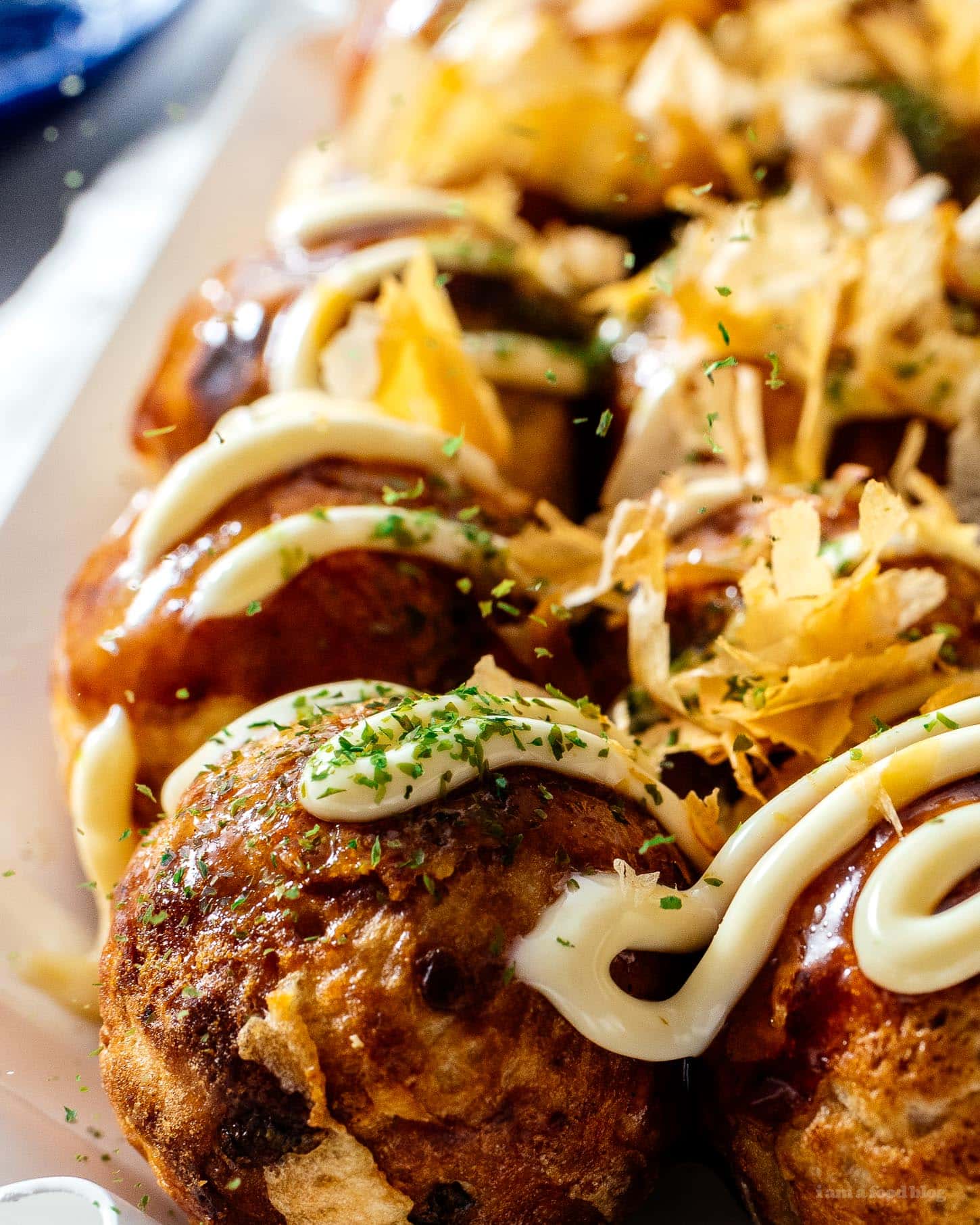

How to make takoyaki
- Mix. Mix the batter up with a whisk making sure there are no floury bits.
- Prep. Prep all of the fillings. Cut up the octopus, slice the green onions and make sure you have everything at the ready: a little dish of oil, all your ingredients, some skewers to flip the balls, and a plate to serve on. Heat up the pan.
- Pour and fill. Generously oil the pan with a brush or a paper towel dipped in oil. Give the batter a whisk then pour into the individual compartments all the way up to the top. It’s okay if they overflow a bit. Add in the fillings and let cook until the edges start to look more solid and opaque.
- Flip. Use your skewers to turn the takoyaki 90 degrees. If they don’t easily move, they need more time to crisp up. Once they’re at a 90° angle, pour in a bit more batter to ensure a super round ball. Let cook, stuffing in any excess batter that’s outside the ball, then turn again. You should have a round ball. Cook until the balls are crispy and brown, moving the balls around from mold to mold to evenly cook (this is because most pans will have uneven heating). As the balls crisp up, it will be easier to flip them.
- Sauce. When the balls are golden and crisp, pop them on a plate and brush with takoyaki sauce and squeeze on some mayo.
Top. Finish with a sprinkle of bonito and aonori. Enjoy!
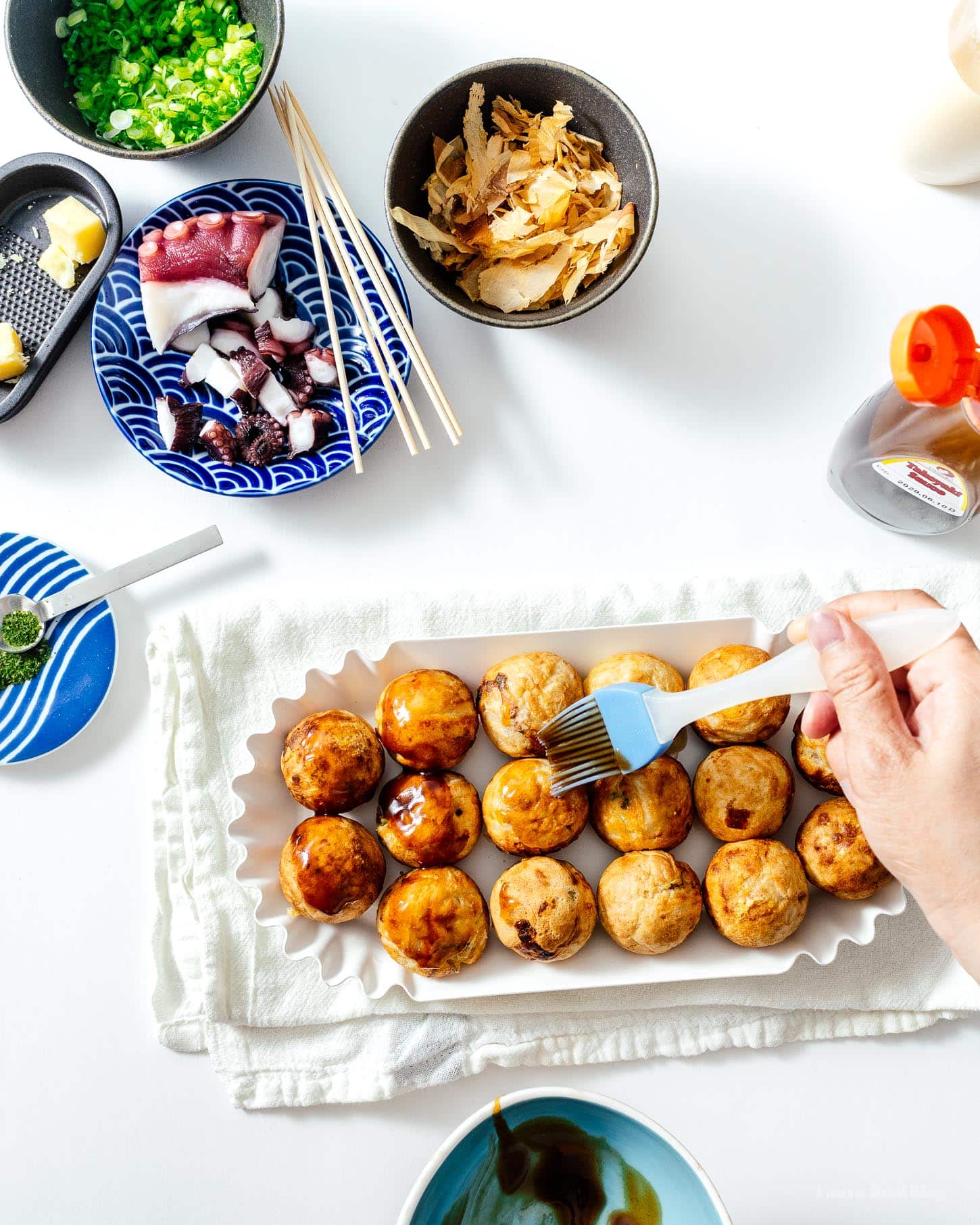

Takoyaki tips and tricks
- Pre-make the batter. It can hang out in the fridge, covered and the flour can really get hydrated, making the batter smooth. It’ll help the crispiness of the outsides.
- Use a lot of oil. Oil is what is going to make the outsides crispy and easy to flip.
- Use a generous amount of batter. Professional takoyaki vendors almost always overfill the rounds of their grills and stuff the excess inside the ball so that each ball is perfectly round. Top up the batter if needed.
- Move the balls around. After the balls are lightly grilled and hold their shape, move them around the pan. Lots of home takoyaki pans have uneven heat so moving them around with help with browning.
Do I have to put octopus in takoyaki/what can you put in takoyaki?
If you don’t like tako, you’re in luck because you can put literally anything you want in takoyaki. Technically it won’t be called takoyaki anymore, but it’ll still be delicious! In Japan they have lots of varieties. Some ideas:
- shrimp
- chicken cubes
- ground beef
- ground pork
- sausage
- bacon
- tofu
- cheese + anything else because everything is better with cheese
- mochi + tako
- kimchi + cheese
- diced ham + tomato sauce + cheese for a pizza version
- taco meat + diced tomatoes + cheese for a taco version
- vegetables: diced carrots, corn, peas, cabbage, zucchini, mushrooms, etc
What sauces go on takoyaki?
Once you have made the balls, finish by brushing on super savory takoyaki sauce and squeezing on kewpie mayo.
Kewpie mayo
Kewpie mayo is a Japanese mayo that is sweeter, a little bit acidic and so much more delicious than regular mayo. It’s made with just yolks as opposed to all other mayos which are made with whole eggs, giving Kewpie an extra rich custard like texture. It’s slight sweetness comes from rice vinegar. It comes in an iconic super soft squeeze bottle with topped off with a little red flip cap.


What is takoyaki sauce made of?
Most Japanese people buy their takoyaki sauce at the store and I do too! It’s a thick brown sauce that’s similar to Worcestershire sauce but more fruity and thick. It comes in a handy squeeze bottle with a cute octopus on it. It’s really similar to okonomiyaki and tonkatsu sauce, so if you have those in the fridge you can use them too. Takoyaki sauce is sold online and in Asian grocery stores. If you need to make a sub at home, make this easy version: mix together 2 tablespoons ketchup, 1 tablespoon Worcestershire sauce, 1 tablespoon mirin, 1 tablespoon soy sauce, 1 tablespoon ketchup, 2 teaspoons oyster sauce, and 1 teaspoon sugar.
What goes on top of takoyaki?
After the sauces, a handful of katsuobushi and a sprinkle of aonori are added for the finishing touch. Katsuobushi is dried bonito flakes and they’re those little whisps that look like they’re dancing when your takoyaki is hot. Aonori is a powdered seaweed. They sell both katsuobushi and aonori online and in Asian grocery stores. If you don’t have aonori, you can use seaweed strips! Unfortunately there isn’t really a sub for katsuobushi.


Aonori: those pretty green sprinkles of seaweed
Aonori is green seaweed that’s been dried and powdered into small flakes. It’s used to finish dishes like okonomiyaki, yakisoba, and takoyaki. It’s not quite the same as regular roasted nori/seaweed – it’s a different variety, much like how romaine and iceberg are both lettuces, but they taste quite different. Aonori is full of umami and a robust briny flavor that will remind you of the sea. You can find it in Asian grocery stores or online.
Where can I buy a takoyaki pan?
We actually have two takoyaki pans, one that my friend gifted me and one that we bought on amazon. You can also purchase them in Japan and sometimes in Asian supermarkets. I love the electric takoyaki pan but if you have an ebelskiver pan you can also make larger takoyaki on the stove. They also sell cast iron takoyaki pans too.
How do you make takoyaki without a pan?
Unfortunately you can’t – you need the half-sphere shapes to really make that round ball shape.
How to store takoyaki?
You might be wondering, how long does takoyaki last in the fridge? If you happen to make extra, you can keep it in the fridge in a covered container for a day or two and heat it up in the microwave but it won’t taste as good as fresh, especially if it has all the sauces on it. What you should do, if you have extra batter is just put everything in the fridge as is and then make takoyaki again, fresh, the next time you want to eat it. The batter and toppings should last up to two days in the fridge.
FAQ
Does takoyaki always have octopus?
Nope, like it says earlier in the post, there are lots of takoyaki in Japan that don’t actually have octopus. They sell shrimp and squid varieties too. You can put any protein inside and even just leave them plain if you don’t want anything in the middle.
Where is takoyaki from?
Takoyaki originated in Osaka in the early 1900s then became popular as street food. Nowadays it’s sold by street food venders, as well as being sold in combini (convenience stores), supermarkets, food courts, bars/restaurants, and specialized restaurants all over Japan.
How do I make perfectly round balls?
Make sure you over fill the rounds. Generously oil the pan, pour in the batter, add the fillings, then top up the batter so that you have extra batter to stuff into the balls, so that they fill out and become perfectly round.
Which pan do you recommend?
I like this electric takoyaki pan that is super cute and has an octopus on it. A word of warning: The heat on these cheaper pans isn’t perfectly even so I always make sure to move my takoyaki around so each ball gets grilled evenly.
Where to get takoyaki
If you don’t want to make takoyaki at home, your best bet to try it would be to check out a Japanese izakaya restaurant in your home town. They might have it on the menu. You can also try frozen takoyaki, which they’ll sell at Japanese supermarkets. But those aren’t quite the same. It’s really easy to make them at home so I hope you give it a try!


Takoyaki Recipe
Ingredients
Takoyaki Mix
- 3 large eggs lightly beaten
- 4.25 cups cold water
- 2 tsp instant dashi
- 2 tsp soy sauce
- 1/2 tsp salt
- 2.5 cups all purpose flour about 300g
Takoyaki Filling
- 1/2 lb boiled octopus 0.5″ cubed
- 1 bunch green onions sliced
- 1 cup tempura bits or rice krispies
- beni shoga/pickled ginger if desired
- shredded or cubed cheese if desired
Takoyaki Toppings
- mayo preferably Japanese/Kewpie Brand
- takoyaki sauce
- bonito flakes
- aonori or seaweed strips
Special Equipment
-
Takoyaki Pan
Instructions
-
Beat the eggs and add the water and stock granules. Add the egg-water-dashi mixture to the flour and salt and mix well. Heat up your pan and oil the individual compartments with a oil brush or use a paper towel dipped in oil.


-
When the pan is hot, pour the batter into the individual compartments up to the top. Don’t worry if the batter over flows a bit.


-
Add green onions, your protein, tempura bits/rice krispies, ginger, and shredded cheese (if using).
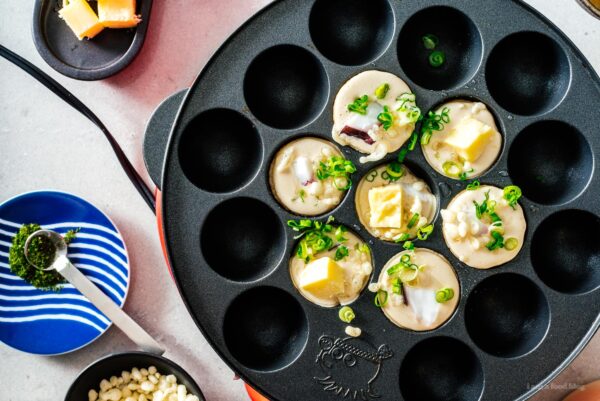

-
After a while, the bottom of the takoyaki will be cooked through. At this point, you can use a skewer or two to turn them over 90 degrees. If you can’t turn the takoyaki easily, it probably needs to cook for a bit longer. If needed, add a bit more batter to the balls to fill them up. Let cook for a minute or so and then do another 90 degree turn. The balls will become easier to turn the more they cook.
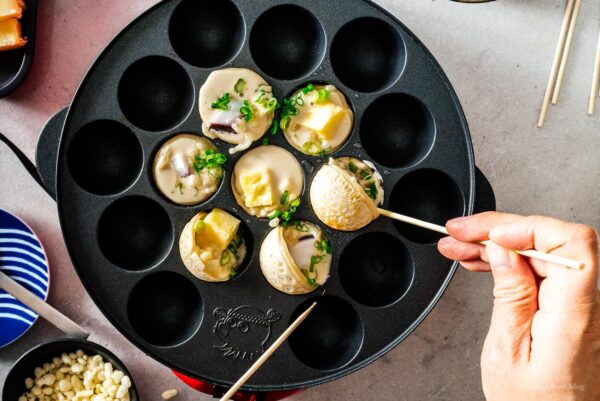

-
The takoyaki are done when they’re lightly brown and crispy on the outside and they turn easily in their holes. Overall I’d say it takes about 10-15 minutes per batch, from start to finish, depending on how crispy or soft you like your takoyaki.
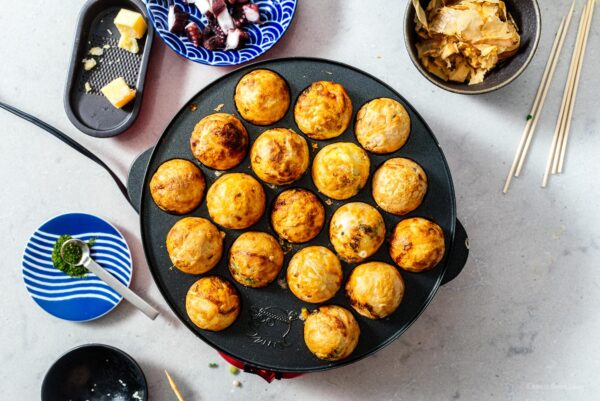

-
To serve, place the takoyaki on a plate and drizzle with Japanese mayonnaise and takoyaki sauce. Genrously sprinkle on the bonito flakes and aonori. Enjoy, but be careful, the insides are hot!
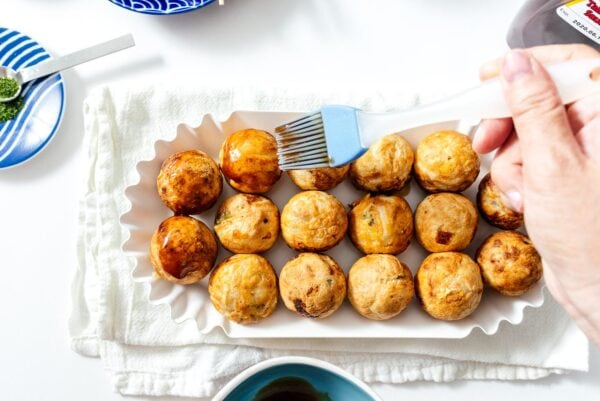

Notes
Estimated Nutrition
Calories from Fat 36










